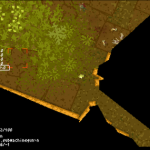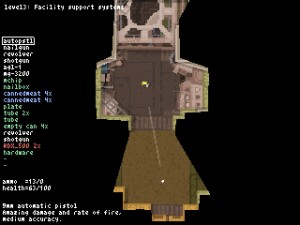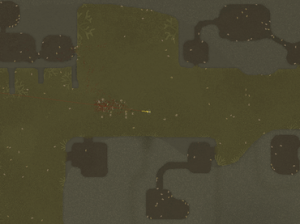 Teleglitch: Die More Edition is published by Paradox Interactive, available here.
Teleglitch: Die More Edition is published by Paradox Interactive, available here.
The Die More Edition has more levels, weapons, enemies and lore
Difficult. Original. Compulsive. Ugly. All of these are words you could use to describe Teleglitch. It’s a game that does its best to turn you away with some of the worst presentation I’ve ever seen in a game, (even in the ultra low budget Indie space), but underneath the veneer of ugly lies a game that’s got considerable depth and is tensely enjoyable.
While I’ve been hugely positive about games recently (publicly decrying anyone who complains that games aren’t as good as they used to be), I’m not such a huge fan of how games LOOK right now. I love retro themed games and pixel art…. sometimes. But the problem is that retro can be gorgeous and original in its own right, like in Fez, Spelunky or DustForce, however it can also hide a general lack of effort in the art department. You can get away with a lot by saying your game is supposed to look bad. How many of these small devs teams could benefit from hiring a proper artist though?
For example, I know many loved Thirty Flights of Loving’s simplistic visuals but I thought they let the game down with there spectacular lack of ambition. Similarly, Kentucky Route Zero is a brilliantly atmospheric game but its visuals add little to the experience. It’s great that there are fewer barriers to entry for indie devs to get their games out, but this can mean that they release a game too early. We can end up playing something that’s more like a proof of concept for the more polished, better looking version of what they should have made, but we never got to play.
 And that’s Teleglitch. It’s a game that screams out for an artist; it demands some snazzy visuals to match the clever gameplay systems its developer has created. Instead, we have a world made up of multiple muted shades of brown (at least initially) and some chunky pixels that represent mutants and monsters and soldiers. You’ll only know that if you read the in-game bestiary though, because their depictions in-game are thoroughly abstract.
And that’s Teleglitch. It’s a game that screams out for an artist; it demands some snazzy visuals to match the clever gameplay systems its developer has created. Instead, we have a world made up of multiple muted shades of brown (at least initially) and some chunky pixels that represent mutants and monsters and soldiers. You’ll only know that if you read the in-game bestiary though, because their depictions in-game are thoroughly abstract.
And in a way, when it comes to designing low pixel characters, the developer has tied their own noose. Mario is instantly recognisable, but he’s also a paragon of economic pixel design. He has a hat and a moustache because those are easy to represent with a tiny number of pixels. Teleglitch may construct characters with a similarly low number of pixels, but they fail to create recognisable shapes with those pixels. With so many classic games for comparison (like Mario), you just need to look at those to see how to create characters with an economy of pixels that are still representative of what their artist were trying to depict. So once again I have to say that Teleglitch is a game that should have included an artist in its development process. And what’s with the muted colour palette and surfeit of brown?
So ugliness aside, what is Teleglitch? Well the developers themselves reference Rogue in its description and there are certainly some elements of that classic in its make-up. It’s a top down game with a focus on finding items in the environment and combining them to build weapons and provisions to help you as you try and escape a space station filled with mutants, zombies and other blobby things. The levels are procedurally generated, so there will be random layouts, enemies and items each time you play, and when you die you start all over again. The game is split into levels, but because of the random layouts I found that sometimes I could play the first level for half an hour before getting to the next level, and other times I was almost right next to the exit when I started.
 You can physically attack enemies by left clicking, but if it comes to this then you are probably in trouble. More often you are shooting enemies, aiming by holding the right mouse button down (which draws a little line showing the direction you will shoot in). Enemies dart around, dodging your shots, and the lack of ammo means that the game takes on a survival-horror feel where every shot counts.
You can physically attack enemies by left clicking, but if it comes to this then you are probably in trouble. More often you are shooting enemies, aiming by holding the right mouse button down (which draws a little line showing the direction you will shoot in). Enemies dart around, dodging your shots, and the lack of ammo means that the game takes on a survival-horror feel where every shot counts.
The game takes place in a space station where an experiment has gone horribly wrong and you are the last remaining human. The titular Teleglitch has been caused by experiments with teleporters, and you have to find one to get you back to Earth, and safety. The game drip feeds its story through terminals that you find as you play, and even though you will die often and start over, finding more and more of these terminals each time you play fills in the blanks in a journal. It’s an incentive to keep playing; you might be starting back at the beginning again but you have a chance each time of finding the elusive terminals that you haven’t yet unlocked.
The item system is the most engaging part of the game, and it’s another reason to play over and over again. While some of your playthroughs may be bereft of ammo or supplies, other times you might be lucky enough to find an assault rifle right at the start. When you do this you become more determined to progress further than before. If you get through enough levels you unlock a kind of checkpoint that lets you start from there, but these checkpoints are so far apart that it will take a really good (and lucky) run to get to one.
 Teleglitch gets the gameplay fundamentals just right. The combat is tough and enemies are frightening. Your weapons are powerful and generally the mutants you face go down easily, but you need to hit them first and they tend to dodge your attacks very ably. It’s easy to get into a panic and lose more health than you should, and slowly and methodically exploring areas while keeping your guard up is the surest means of making significant progress.
Teleglitch gets the gameplay fundamentals just right. The combat is tough and enemies are frightening. Your weapons are powerful and generally the mutants you face go down easily, but you need to hit them first and they tend to dodge your attacks very ably. It’s easy to get into a panic and lose more health than you should, and slowly and methodically exploring areas while keeping your guard up is the surest means of making significant progress.
The controls work perfectly, with your little avatar feeling responsive and capable, while the on screen interface is simple and unobtrusive. A whole list of your inventory items is shown down the left of the screen, and using the mouse wheel moves you through them, while simply pressing C shows what items can be combined and what the result will be. From nail guns to Panzerfaust’s, the weapons you create are great fun to use. When you go on a little run of luck and find multiple useful items, weapons and ammo it really draws you in as you mentally commit to progressing far enough to unlock the later levels. It’s a serious challenge, but every new game gives you another chance to craft some new makeshift weapon that could be your key to survival and eventual escape.
 So while I have real misgivings about the presentation and visuals of Teleglitch, I really enjoyed actually playing it. It may have the front-end and loading screen of a BBC Micro spreadsheet program, but it plays really well. The story is typical sci-fi fare about a failed experiment on a military base in a world of space mega-corps, but its uncovered in such a gradual way that it’s interesting to piece together. The audio is generally muted and unspectacular, but the sounds of the mutants are frightening enough, especially because they signal the arrival of an enemy who can undo hours of productive play in a few agonising seconds. Finally, Teleglitch is one of those games that is tough but engaging. It will kill you suddenly, but somehow the promise of surviving a little longer makes you likely to start a new game every time you die.
So while I have real misgivings about the presentation and visuals of Teleglitch, I really enjoyed actually playing it. It may have the front-end and loading screen of a BBC Micro spreadsheet program, but it plays really well. The story is typical sci-fi fare about a failed experiment on a military base in a world of space mega-corps, but its uncovered in such a gradual way that it’s interesting to piece together. The audio is generally muted and unspectacular, but the sounds of the mutants are frightening enough, especially because they signal the arrival of an enemy who can undo hours of productive play in a few agonising seconds. Finally, Teleglitch is one of those games that is tough but engaging. It will kill you suddenly, but somehow the promise of surviving a little longer makes you likely to start a new game every time you die.
If only it was a little prettier! I think I could stand the it if the developers had made the game several shades of space-y blue, but instead we have a game that’s fifty shades of shit. All this ugliness means that while I may like Teleglitch, I can’t love it. I look forward to seeing what the developers do in the future, and if it’s a sequel of some sort (and they hire an artist) then I would be really excited to play it. As it is, I can give Teleglitch only a cautious recommendation to those who are less superficial than I am.
7 sweating palms as the ammo counter ticks down out of 10
